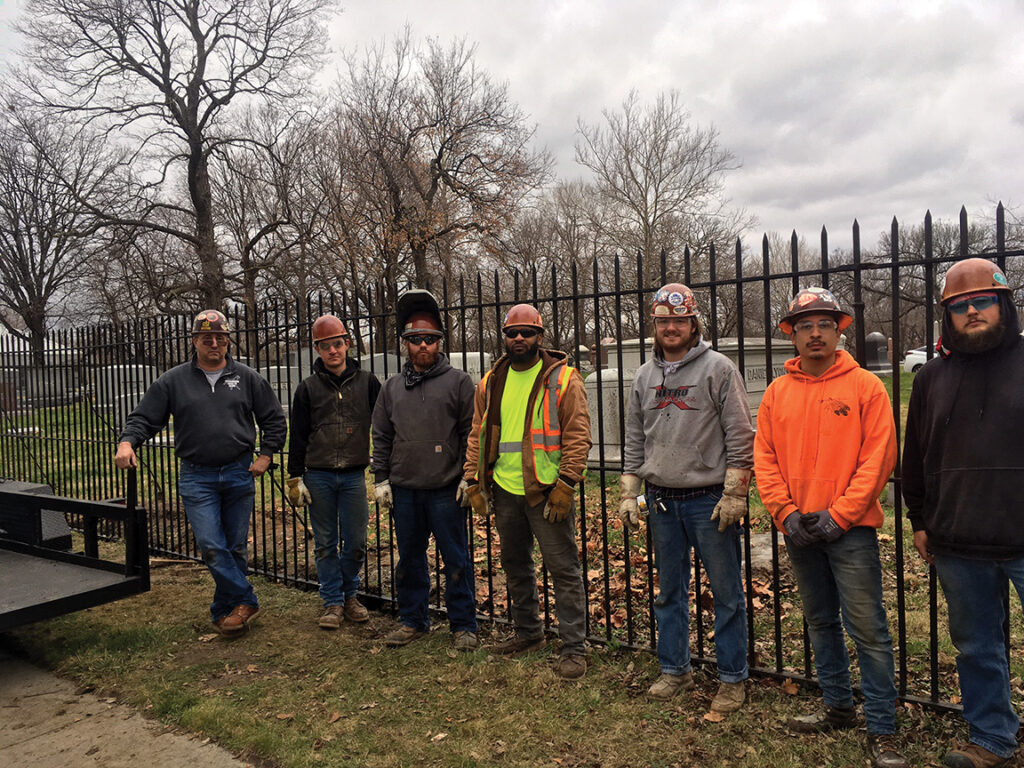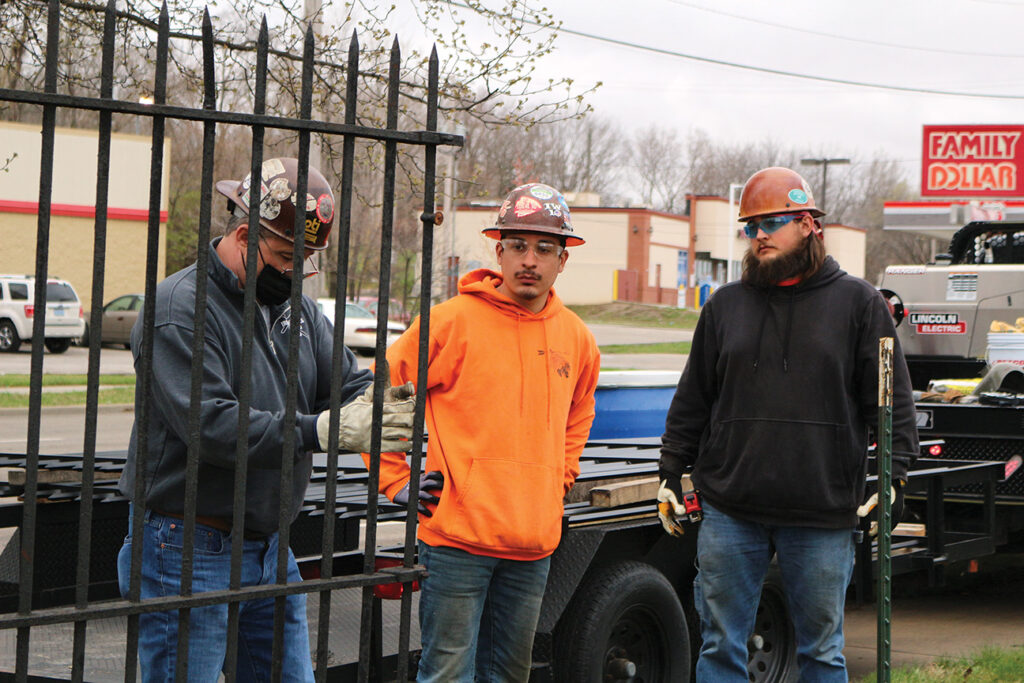
Abby Hoover
Managing Editor
Since a hit-and-run last October, two panels of iron fence have lain on the ground of Elmwood Cemetery along Truman Road. Since then, temporary fencing has done little to keep out unsavory activity and litter. On Wednesday, March 24, that finally changed when apprentices from Ironworkers Local 10 installed a permanent replacement free of charge.
John Weilert, President of the Board of Trustees of Elmwood Cemetery Society, was on site to facilitate the long awaited repair. He grew up in the funeral business and has been volunteering with the cemetery for close to 20 years.
“For me, I remember [Elmwood] as a little kid, and so there’s an element of nostalgia involved,” Weilert said. “Elmwood is very interesting because it really is a snapshot of the history of Kansas City, and it has a lot of national overtones to it. A lot of people who were buried here did things on a big scale. It’s a history lesson all contained within these 43 acres.”
Weilert said at this point, there’s not really room for the cemetery to grow. It was designed in 1872 by George Kessler, who designed Kansas City’s parks and boulevard systems, and the grounds of the World’s Fair in St. Louis.
“He’s a world famous landscape architect, and you can see the influence of the park designer in the grounds here,” Weilert said. “We have about 33,000 people buried here, and when you run out of room there’s no more revenue from burials, but the grass keeps growing. Things continue to deteriorate and you need to fix them. That’s a real challenge.”
The Elmwood Cemetery Society was formed in 1896 as a benevolent corporation. Now they rely mostly on donations from families and others in the community to help keep Elmwood going. The cemetery is run solely by volunteers and has no employees.
Knowing the cemetery couldn’t afford to repair the fence, Weilert called Local 10. They immediately agreed to lend a hand.
“One thing about being in a situation like this is you get good at scrounging and asking,” Weilert said. “I figured there are no better welders in town than ironworkers, and they have a training school… They’ve been wonderful.”
Weilert had called on Local 10 a few years ago to work on a different section near Van Brunt Boulevard and they had been very responsive.

Cemetery volunteer Jim Taylor, an Independence resident, began spending most of his week at Elmwood after retiring following a 35-year career in Kansas City as an electrician.
“I know we may have to do it several times over, but you can see your accomplishment for the work you do out here,” Taylor said. “ Whether it’s bagging up leaves or cutting up a tree limb into small amounts, it’s all part of it, and I’ve got family here, too.”
Whether their families have moved away from the area or passed on themselves, for some laid to rest in Elmwood, the volunteers are the only ones who care for their final resting place.
“They can’t do nothing for themselves so this is sort of payback for the legacy that they’ve left,” Taylor said.
The section this particular fence borders is one of the first Jewish cemeteries in Kansas City. Temple Congregation B’nai Jehudah, purchased the plots for its congregants in the early 1900’s.
“A lot of very prominent Kansas Citians are buried here and B’nai Jehudah has just been wonderful to the cemetery,” Weilert said.
A tradesperson himself, Taylor was thrilled to have the apprentices working on the project.
“This is great, we really appreciate this because they’re young men and we’re all old,” Taylor said. “We don’t have income like a newer cemetery. This is an old cemetery. They’ll have a few burials out here, but not enough to create a constant flow of money, so that’s always an issue and that’s why we appreciate these guys doing what they’re doing.”
The ironworkers apprenticeship program wanted to do more than just a “patch job,” Weilert said. They custom made the two new panels to replicate the original fencing on either side. Each new panel weighs about 200 pounds. The apprentices who installed them are in their second year of a four-year program.
“They’re on the job training, 90% of their training is going to be in the field while they’re working,” said supervisor Joe Eckstein. “When they come into the school it’s more for the academic side and the certification side.”
They worked on this project as part of their ornamental, welding and fabrication curriculums, said Eckstein, who has been in the trade since May 1994. He began working with the apprenticeship program because he found himself already teaching in the field.
“It’s the only thing left with decent money and benefits,” Eckstein said of trade work. “If you go to school for $40-50,000 a year [to then make] $40-50,000 a year, you never catch up. You never dig yourself out of that hole.”
Local 10 was founded in 1898. The work that ironworkers do falls into a number of related segments, and most Ironworkers will do more than one type of work, including structural ironwork, ornamental ironwork, reinforcing ironwork and rigging ironwork.

















